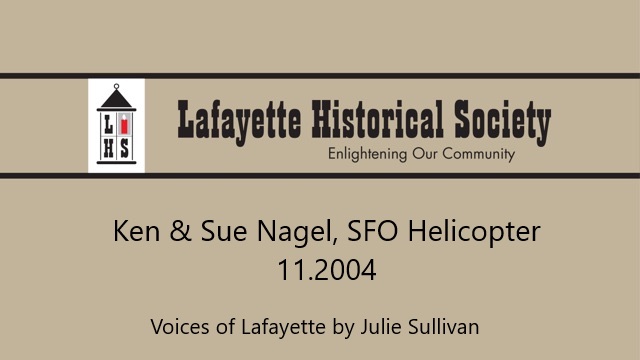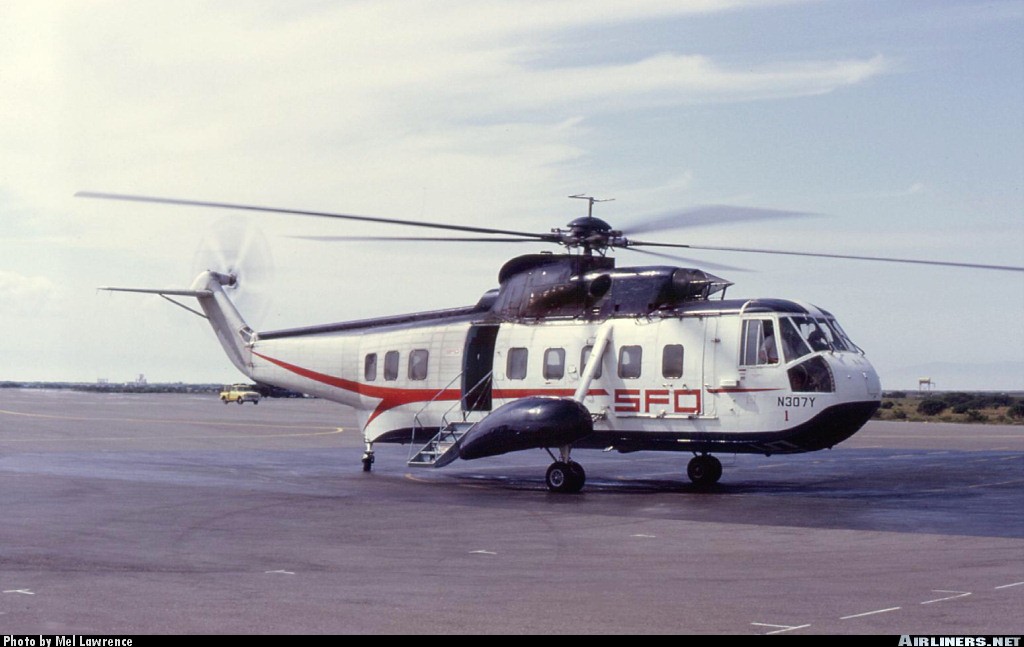Summary:
Ken Nagel and his wife Sue Nagel were interviewed by Julie Sullivan in November, 2004.
Ken was an attorney, and later also a member of the Board of Directors, for SFO Helicopters. This service carried passengers from Lafayette to and from San Francisco International Airport and also six other locations around the Bay Area. Ken Nagel describes some of the business challenges which resulted in the Lafayette heliport serving customers only from 1965 to 1968, and the company ending all of its operations in the early 1970’s.
The Nagels also share memories of their experiences as 40-plus year residents of Lafayette.
Oral History:
Can you picture helicopters flying passengers in and out of Lafayette twice a day? It may sound far-fetched, but SFO Helicopters is part of Lafayette’s not-too-distant history. For a handful of years from the late 1960’s to the early 1970’s, the service carried passengers from Lafayette to destinations throughout the Bay Area.
Ken Nagel’s law firm represented SFO Helicopters from the time it was incorporated, and Ken eventually became a company director. “They operated a regular, scheduled service around the Bay Area,” he explains. “The heliport was on the north side of Mt. Diablo Boulevard right above the Hillside Motel, above Sunset Village. The site wasn’t difficult to put in. The helipad was just a level space that didn’t require that much land. I don’t believe the freeway ran above it then. But it was a great annoyance to the people in Sunset Village, one of the reasons it was eventually closed down.”
The company started out with a heliport next to the Ferry Building in downtown San Francisco. Additional heliports were located at San Francisco airport, downtown Oakland, Oakland airport, in Berkeley, Lafayette, Concord, Marin County, and Palo Alto, and Ken believes there was one in San Jose for a short time. “It was a scheduled airline, certificated by the Civil Aeronautics Board. The helicopters were essentially a feeder system for passengers going to the airports. I think they had four helicopters, and one hovercraft which operated from Oakland airport.
“But it had a basic imbalance,” Ken adds, “because everybody was going to SFO in the morning and coming back in the evening. There was little traffic the other way. That was the reason the operation really didn’t survive.” Following the last flights to Lafayette on July 19, 1968, the operation moved to Buchanan Field, but patronage declined, and SFO Helicopters ultimately went out of business. The company declared bankruptcy in the early 1970’s, and its helicopters were sold. (Lloyd MacDonald, a former officer of SFO Helicopter, when contacted by phone added that another cause of the company’s demise was excessive maintenance costs of the equipment which ticket prices could not cover. “SFO Helicopters survived only because it received a subsidy from American Airlines and TWA for bringing passengers to their gates at SFO,” according to Lloyd.)
SFO Helicopter was only one part of Ken’s legal career. A partner in Pillsbury, Nagel and Atchison in San Francisco, he graduated from law school at Cal Berkeley. He was born in Idaho and later moved to the Bay Area. He and his wife, Sue, a Berkeley native, met in law school and were married in 1952. The couple moved to Hanford (near Fresno) in the San Joaquin Valley. “Ken is a former District Attorney of Kings County,” Sue says proudly. “That was a long time ago, fifty-two or fifty-three years,” Ken adds. The couple moved to Lafayette in 1957 and have attended St. Stephen’s Episcopal Church in Orinda for forty- eight years. They have three children and six grandchildren. Ken retired in 2002, and the couple now live in Rossmoor.
After more than forty years of living in Lafayette, Ken and Sue marvel at the changes that have taken place. Sue remembers summers at her grandfather’s home near the Diablo Country Club. “People don’t believe you when you say you came out here for summer vacations.” Ken made his first solo attempt at driving in the 1930’s, “on the ‘quiet, two-lane road’ that linked Lafayette and Orinda.
“The main highway from Walnut Creek to Berkeley used to go right through the middle of Lafayette, and you can’t conceive of that now,” Ken says. “The town used to be concentrated more near Bill’s Drugs. Lafayette was a marvelous small town, and still is. There were a lot of things for children to do. The schools were excellent.
“The town doesn’t seem as different today, as you might imagine, than it was in the 1960’s,” he adds. “The buildings on the south side of Mt. Diablo haven’t really changed that much. On the north side as you go west, I think there’s been a significant change. And the Park Hotel makes that end of town a little different. The building supply business Joe Newell and Bill Gardner ran was across the street from the Park Hotel.
“The construction on the eastern end of Mt. Diablo between the hotel and downtown, the fire house and some of the other new buildings, are the big change. I think if anything Lafayette is a nicer-looking town now than fifty years ago. I think the quality of the buildings has improved.”
“Time and again we comment that Lafayette is really a wonderful, small town,” Sue says. “It’s a little town, not a suburb. It has a history to it. It’s maintained its underlying character.”
Ken and Sue also enjoy the sense of history in their Rossmoor location. “The valley where Rossmoor is located was the Stanley Dollar Ranch, and the Dollar Clubhouse was the family home,” Ken explains. “Imagine, one family owned the entire valley. Now there are 10,000 people living here.”
Sue is active in the American Association of University Women and the Daughters of the American Revolution. Her grandfather, Captain Albert Pillsbury, was an English clipper ship captain who arrived in San Francisco in 1893. Paintings of his ship, the Stanhope, one done by Sue, adorn the walls of their Rossmoor home.
“I think people will try to keep Lafayette the same in the future,” Sue says. “They like the small town atmosphere.”
“The town could only spread east and west because of the contour of the land, but it would take a long time to change to a commercial area, and that’s fortunate,” Ken adds. “People here have a pride in Lafayette that they don’t have in some cities.”
Excerpted from “Voices of Lafayette” by Julie Sullivan. This book is available for purchase in the History Room.



Leave a Reply